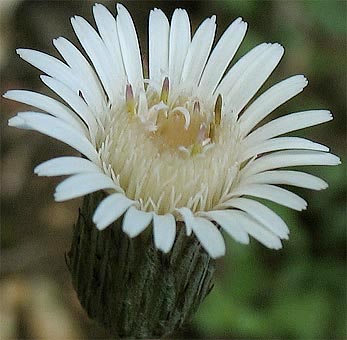
- a peripheral series of ligulate (ray-like) pistillate flowers (which may be greately reduced* or even missing — heads lacking this series are bimorphic)
*Reduction of the peripheral florets in the populations studied ranged from short, erect ligules, extending only slightly above the phyllaries (Type II) to vestigial ligules shorter than the style branch point (Type III) to eligulate florets with tubular corollas longer than half the length of the style (Type IV & fall-to-winter heads of all populations). Only a few heads during the fall period were found to be truly bimorphic.
Two specimens among the 40 Texas specimens in the TEX/LL herbaria appear to be bimorphic, but without carefully dissecting the entire head (as was done with the fresh specimens studied), it is not possible to determine whether these are truly bimorphic. - a central group of perfect flowers (similar to disc flowers)
- an intermediate (large) group of eligulate pistillate flowers with tubular corollas (not more than than half the length of the style)
The species are characterized by dimorphic heads: those produced in the spring appear before or with the leaves and are chasmogamous and quasi-radiate; the fall forms appear after the leaves and are cleistogamous (not exposing any florets but setting full fruit).*I have long been familiar with the nodding closed heads of C. texana in the hill country west of Austin, Texas, but in mid March of 2010 I came across a population with an erect open head with ray-like ligulate florets (Type I in this presentation). The Texas Chaptalia literature did not seem to fully account for either this new type or the more familiar type. The Chaptalia authority Guy Nesom has encouraged me to pursue this issue further, so I have done my best to provide detailed descriptions of the various types that were available to me from spring 2010 through January 2011.
*Although the details of the dimorphism described by Nesom only apply to Type I, the fall/winter heads of Types II & III are either bimorphic or exhibit peripheral florets without ligules.
Before proceding with own collections I examined all C. texana Texas specimens in the TEX/LL herbaria. But in light of what I found with the fresh materials, I was obliged to visit the herbarium specimens yet several more times, each time discovering features missed in my initial inspection.
Especially upon closer examination of the closed head forms I realized that I had not fully appreciated their diversity of floret structure, and I was able to identify two distinct larger populations in N. Hays County: one with small ligules, visible at anthesis (type II); and one with vestigial ligules, often difficult to discern even with a microscope (type III). Additionally, two subtypes for individual plants not associated with the above two populations were also found: one intermediate between type II and type III; one with no ligules, but with peripheral florets exhibiting a long tubular corolla (in contrast to the nonperipheral pistillate florets).
The main differences for the three main types are summarized in the following table.
| I. Travis Co., Barton Creek Greenbelt |
II. N Hays Co., adjoining Deadman's Creek |
III. N Hays Co., a valley above Deadman's Creek |
|
|---|---|---|---|
| trimorphic florets | yes | ||
| reproduction | chasmogamous | apomictic (?plus chasmogamous) | |
| florets per head | 91–106 (avg 97) | 36–85 (avg 56) | 67–73 (avg 69) |
| ligules | showy | visible, barely exerted at anthesis | virtually invisible (require microscope) |
| anther tube of perfect florets exerted |
yes | no | |
| corolla tube length of eligulate pistillate flowers | 3.1–3.8 mm (average 3.6 mm) |
3.6–5 mm (average 4.6 mm) |
4.5–6.2 mm (average 5.2 mm) |
| styles of eligulate pistillate flowers | clearly visible when heads open, not when heads closed | hidden by pappus bristles, but may become visible when darkened in older heads | |
| pappus length | avg. 9.4 mm | avg. 12–12.9 mm | |
| heads open at anthesis | yes; diurnal | no | |
| head ‘nodding’ behavior: | |||
| head nodding in bud*
*short, conical shaped head on short peduncle |
bud initially drooping ±180°; rising as peduncle develops to ±90° | ||
| head erect during early anthesis | yes | no; upper peduncle bends down | |
| head nodding during late anthesis | yes, but never to 180° | upper peduncle gradually bends to ± 180° | |
| head angle at dispersal | the entire peduncle straightens to ±erect, with only the very apex tilting downward | ||
| 20° – 105° | 0° – 48° | 0° – 24° | |
| peduncle length at dispersal | 20–46 cm (avg 33 cm) | 5–27 cm (avg 14 cm) | 9–34 cm (avg 24 cm) |
| peduncle cortex asymmetrically thickened | no | yes | |


